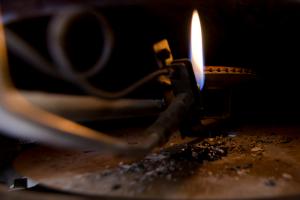Mastering the Art of Lighting a Pilot Light: A Complete Guide

-
Quick Links:
- Introduction
- Understanding Pilot Lights
- Safety First
- Tools You Need
- Step-by-Step Guide to Lighting a Pilot Light
- Troubleshooting Common Issues
- Expert Insights
- Case Studies
- Conclusion
- FAQs
Introduction
Lighting a pilot light might seem daunting, especially if you are unfamiliar with gas appliances. However, it is an essential skill that can save you time and money. This comprehensive guide will walk you through everything you need to know about pilot lights, from understanding their function to troubleshooting common issues.
Understanding Pilot Lights
A pilot light is a small flame that ignites gas appliances, such as water heaters, furnaces, and stoves. They are designed to remain lit continuously, providing a reliable source of ignition. Understanding how pilot lights work can help you become more comfortable with your gas appliances.
How Pilot Lights Function
When the appliance is turned on, the gas flows to the burner and is ignited by the pilot light. If the pilot light goes out, the appliance will not function, which is why knowing how to light it is crucial.
Safety First
Before attempting to light a pilot light, it’s essential to prioritize safety. Here are some safety tips to keep in mind:
- Ensure the area is well-ventilated.
- Use a long lighter or match to keep your hands away from the flame.
- Check for gas leaks before proceeding.
- Have a fire extinguisher nearby.
Tools You Need
Gather the following tools and materials before attempting to light a pilot light:
- Long lighter or matches
- Screwdriver (if needed to access the pilot light)
- Flashlight
- Gas leak detector solution
Step-by-Step Guide to Lighting a Pilot Light
Follow these steps to light your pilot light safely and effectively:
Step 1: Locate the Pilot Light
Find the pilot light assembly. It is usually found near the bottom of the appliance, often near the gas valve.
Step 2: Turn Off the Gas
Before lighting, turn the gas control knob to the "Off" position and wait for a few minutes to allow any accumulated gas to disperse.
Step 3: Set to Pilot Position
Turn the gas control knob to the "Pilot" position. This will allow gas to flow to the pilot light.
Step 4: Light the Pilot
Using your lighter or match, ignite the pilot light while simultaneously pressing the reset button on the gas control. Hold for about 30 seconds after lighting to ensure the thermocouple heats up.
Step 5: Turn to On Position
Once the pilot light is lit and stable, turn the gas control knob to the "On" position. Your appliance should now be ready for use.
Troubleshooting Common Issues
If your pilot light won’t stay lit, there could be several reasons:
1. Dirty Pilot Orifice
Cleansing the orifice can often resolve lighting issues.
2. Faulty Thermocouple
A malfunctioning thermocouple can prevent the pilot light from staying lit.
3. Gas Supply Issues
Check if your gas supply is turned on and functioning properly.
Expert Insights
Experts recommend checking the pilot light regularly to ensure it is functioning correctly. Regular maintenance can prevent unexpected failures and enhance the longevity of your appliances. Consulting a professional if you encounter persistent issues is advisable.
Case Studies
Case Study 1: Residential Water Heater
In a recent case, a family faced issues with their water heater's pilot light. After following the steps outlined in this guide, they managed to relight the pilot successfully, restoring hot water in their home.
Case Study 2: Commercial Furnace
A business encountered a malfunctioning furnace. With expert advice and careful troubleshooting of the pilot light, the issue was resolved, ensuring a warm environment for employees and customers.
Conclusion
Lighting a pilot light is a straightforward process that can empower you as a homeowner. With the right tools and knowledge, you can tackle this task with confidence. Remember to prioritize safety and don’t hesitate to reach out to professionals when needed.
FAQs
1. What is a pilot light?
A pilot light is a small flame that ignites gas appliances like furnaces and water heaters.
2. Why does my pilot light keep going out?
Possible reasons include a dirty pilot orifice, a faulty thermocouple, or gas supply issues.
3. How often should I check my pilot light?
It’s advisable to check your pilot light at least once a year or before the heating season begins.
4. Can I light a pilot light without a lighter?
Using matches is an alternative, but ensure they are long enough to keep your hands away from the flame.
5. Is it safe to light a pilot light myself?
Yes, as long as you follow safety precautions and guidelines. If unsure, consult a professional.
6. What should I do if I smell gas?
Evacuate the area immediately and contact your gas supplier or emergency services.
7. Can I use a regular match to light a pilot light?
Yes, but a long match or lighter is preferred for safety.
8. How do I know if my pilot light is working?
A steady blue flame indicates that your pilot light is functioning correctly.
9. What tools do I need to light a pilot light?
You typically need a long lighter or matches, a screwdriver, and possibly a flashlight.
10. If my pilot light won’t light, what should I do?
If the pilot light won’t light after multiple attempts, consider checking for gas supply issues or contacting a professional.
References
For further reading, refer to the following authoritative sources:
- Energy.gov - Lighting Pilot Lights
- Consumer Reports - How to Light a Pilot Light
- HVAC.com - How to Light a Pilot Light
Random Reads